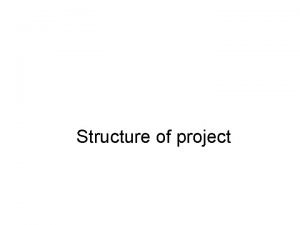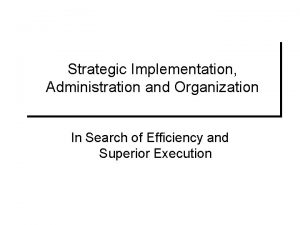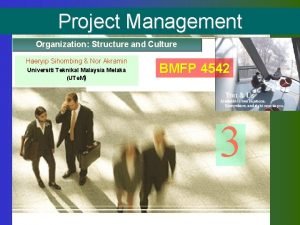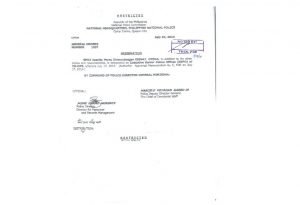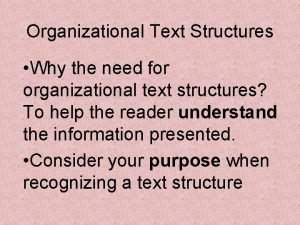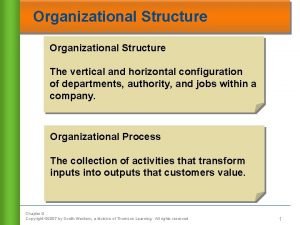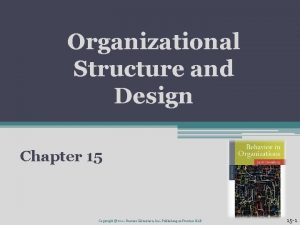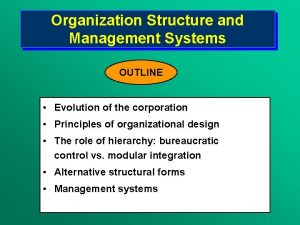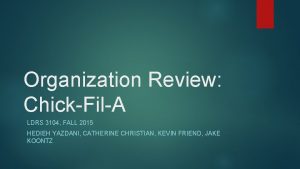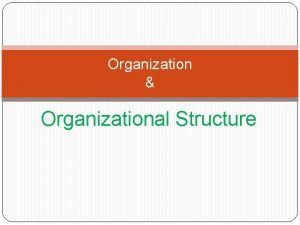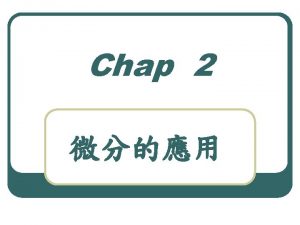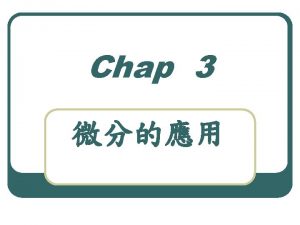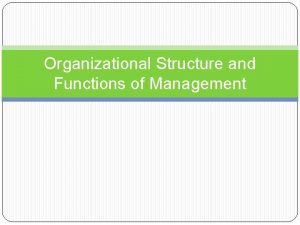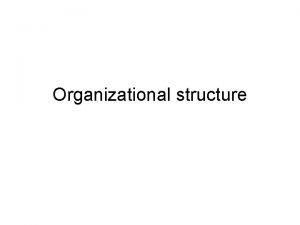UNIT STRUCTURE Unit Structure An Organizational Solution Lessons





















- Slides: 21

UNIT STRUCTURE

Unit Structure: An Organizational Solution Lessons that help students acquire & integrate new core knowledge Traditional Test Lessons that help students extend, refine & use knowledge Holistic Performance Assessment Logical progression of lesson plan objectives that increase in critical thinking levels

Unit Structure: 5 Phases Phase Description Acquiring & Integrating LPs 3 -5 lessons that help students acquire and integrate new knowledge and build toward at least a basic achievement of the Unit Goal Traditional Test Assesses the core concepts and skills and Unit Goal achievement at least at an unsophisticated level Extending & Refining LPs 1 -3 lessons that help students extend and refine knowledge Using Knowledge Meaningfully LP 1 lesson that helps students use knowledge in a new, meaningful way Performance Assessment Holistically assesses student achievement of the Unit Goal

Unit Structure: Integers Unit Goal: SWBAT apply the four basic operations on integers to solve real-world problems. LP 1: SWBAT write opposites and absolute values of integers. LP 2: SWBAT compare integers by ordering them on a number line. LP 3: SWBAT generalize rules for adding and subtracting integers. LP 4: SWBAT generalize rules for multiplying and dividing integers. Traditional Test LP 5: SWBAT graph integer coordinates on the coordinate plane. LP 6: SWBAT apply integers to describe changes in real-world measurements (temperature, elevation, and stock prices). Performance Assessment: After studying a monthly bank statement of deposits, withdrawals, credits, and debits, SWBAT respond to questions concerning the account balance in which they calculate changes between and averages of designated transactions and create a line graph of the daily balances.

Unit Structure: Poetry Unit Goal: SWBAT explain poetic devices such as figurative language, sensory engagement, diction, and form to build comprehension. LP 1: SWBAT identify the basic elements of poetry including meter, lines, stanza, and rhyme. LP 2: SWBAT identify and explain different types of figurative language in a poem. LP 3: SWBAT explain the forms of sensory engagement. LP 4: SWBAT identify and explain elements of diction in a poem. LP 5: SWBAT describe poetic forms. Traditional Test LP 6: SWBAT utilize poetic elements to construct an original poem. LP 7: SWBAT identify poetic devices in order to build comprehension. Performance Assessment: In a 1 -2 page essay, students will explain poetic devices such as figurative language, sensory engagement, diction, and form in the poem “Domestic Work, 1937” by Natasha Tretheway.

Unit Structure: Lesson Plans that Benefit All, Especially Struggling, Students 8 th grade Math Unit Concept: Ratios and Proportions Unit Goal: SWBAT apply unit rates, ratios, and proportions to solve real-world problems. Acquiring & Integrating Lesson Plans LP 1 (2 days): SWBAT write ratios and rates in simplest form. LP 2 (2 days): SWBAT apply ratios and unit rates to describe and compare rates of change. LP 3 (2 days): SWBAT calculate the probably of simple events. LP 4 (3 days): SWBAT solve proportions using cross products. LP 5 (3 days): SWBAT solve problems involving similar figures by writing proportions. Traditional Test (1 day)

Unit Structure: Lesson Plans that Benefit All, Especially Succeeding, Students 8 th grade Math cont’d Unit Concept: Ratios and Proportions Unit Goal: SWBAT apply unit rates, ratios, and proportions to solve realworld problems. Extending & Refining Lesson Plans LP 7 (2 days): SWBAT apply proportional reasoning to solve problems involving scale drawings (maps and small-scale models). LP 8 (2 days): SWBAT apply proportional reasoning to solve problems involving indirect measurement (e. g. “shadow problems”). Using Knowledge Meaningfully Lesson Plan LP 9 (2 days): SWBAT apply proportions to solve word problems in real-world contexts. Performance Assessment SWBAT apply proportional reasoning to calculate the dimensions of various locations around campus using a school blueprint and respond to directed questions.

Unit Structure: Example – 6 th Grade Math Unit Concept: Measuring Area and Volume Unit Goal: SWBAT apply calculations of area and volume to solve real-world problems. Acquiring & Integrating Lesson Plans LP 1 (3 days): SWBAT calculate the area of parallelograms and triangles. LP 2 (2 days): SWBAT calculate the area of circles. LP 3 (2 days): SWBAT describe properties of three-dimensional figures. LP 4 (2 days): SWBAT calculate the volume of rectangular prisms. Traditional Test (1 day) Extending & Refining Lesson Plan LP 5 (2 days): SWBAT calculate the surface area of rectangular prisms. Using Knowledge Meaningfully Lesson Plan LP 6 (2 days): SWBAT use real-world dimensions of common objects to calculate area and volume. Performance Assessment SWBAT compare dimensions of shapes of packaging material to determine how to maximize various areas and volumes for printing labels and shipping.

Unit Structure: Lesson Plans that Benefit All, Especially Struggling, Students 8 th Grade Language Arts Unit Concept: Short Stories Unit Goal: SWBAT infer a valid theme for a short story through the relationship between literary elements including plot, characterization, conflict, symbolism, mood, and theme. Acquiring & Integrating Lesson Plans LP 1 (2 days): SWBAT describe point of view, characters, setting, and situation in a short story. LP 2 (3 days): SWBAT analyze the relationship between plot and conflict within a short story. LP 3 (2 days): SWBAT compare the characterization of key figures in a short story as foils. LP 4 (3 days): SWBAT examine the impact of point of view on the interpretation of plot events. LP 5 (3 days): SWBAT analyze the mood of a short story using setting, characters, and plot. LP 6 (3 days: SWBAT distinguish the multiple meanings of symbols within a story. LP 7 (2 days): SWBAT infer a valid theme from a short story based on specific literary elements. Traditional Test (1 day)

Unit Structure: Lesson Plans that Benefit All, Especially Succeeding, Students 8 th Grade Language Arts cont’d Unit Concept: Short Story Unit Goal: SWBAT infer a valid theme for a short story through the relationship between literary elements including plot, characterization, conflict, symbolism, mood, and theme. Extending & Refining Lesson Plans LP 8 (2 days): SWBAT extract a theme shared by two short stories addressing similar topics. Using Knowledge Meaningfully Lesson Plan LP 9 (2 days): SWBAT infer a valid theme for a short story through the relationship between literary elements including plot, characterization, conflict, symbolism, and mood. Performance Assessment Using the story “Stop the Sun” by Gary Paulsen, students will write an essay in which they deduce a theme for the story referencing specific literary elements including plot, characterization, conflict, symbolism, and mood.

Unit Structure: Example – 7 th Grade Language Arts Unit Concept: Theme, setting & characterization (Literary vehicle: Theodore Taylor’s The Cay) Unit Goal: SWBAT compare theme in two different works of literature, using evidence from literary elements such as setting and characterization. Acquiring & Integrating Lesson Plans LP 1 (4 days): SWBAT identify major physical and cultural characteristics of the setting in The Cay. LP 2 (2 days): SWBAT describe the characters in The Cay. LP 3 (2 days): SWBAT analyze the author’s characterization of an individual in The Cay. LP 4 (2 days): SWBAT support a theme for the novel using evidence from setting, characterization, and point of view. Traditional Test (1 day) Extending & Refining Lesson Plan LP 5 (2 days): SWBAT support a theme for the short story The Monkey’s Paw by W. W. Jacobs. LP 6 (2 days): SWBAT compare and contrast setting, characterization and other literary elements in The Cay and Martin Luther King Jr. 's "I Have a Dream" speech. Using Knowledge Meaningfully Lesson Plan LP 7 (4 days): SWBAT compare and contrast theme in The Monkey’s Paw and a short story they have written, using evidence from literary elements such as setting and characterization. Performance Assessment Given a short story they have never seen before, SWBAT compare theme in The Cay and the new story, using evidence from literary elements such as setting and characterization.

Fractions: Comparing Parts of Wholes Unit # 1 Unit Rationale Unit Goal Unit Prior Knowledge Unit Assessment 3 rd Grade Math This unit follows a unit on time and money. It builds on the idea of parts of an hour or dollar. SWBAT compare fractions and fractional parts of a whole, using < and >. Students can list the number of minutes in parts of an hour. SWBAT compare diagramatically and symbolically liquid volumes as parts of wholes. Estimated Duration 14 Lesson # LP 1 Estimated # of days 2 Lesson Objective Lesson Assessment Objective: Benchmark s, Standards or Mastery Codes Acquiring & Integrating Lesson Plans Students will divide wholes (sticks, pizzas, clock faces, etc. ) into equal parts: 1, 2, 3, and 4 Assessment: Students will compare fractional parts of an hour using number of minutes for the fraction. Objective: LP 2 2 Students will be given several circle or length parts and will name the correct fraction (and explain why the Assessment: choices are correct). Objective: LP 3 2 LP 4 2 LP 5 1 LP 6 2 SWBAT identify the parts of a whole corresponding to unit fractions 1/2, 1/3, and 1/4 and unit fractions corresponding to parts of a whole. SWBAT explain the fraction 1/5, 1/6, 1/7, and 1/8 that corresponds to parts of a whole and the parts which corresponds to fraction symbols. Students will be given several fractions and will identify the correct parts of wholes (and explain why the choice is Assessment: correct). Objective: SWBAT compare using < and > unit fractions. Assessment: SWBAT compare 2 sets of 3 fractions using < and >. Objective: Assessment: TRADITIONAL TEST Objective: Extending and Refining Lesson Plans SWBAT convert unit and non-unit fractions into designated equivalent fractions. Assessment: SWBAT convert 2 pairs of cake fractions into designated equivalent fractions. LP 7 2 LP 8 1 Objective: Assessment: SWBAT predict liquid volume comparisons, using equivalent fractions. Objective: SWBAT use equivalent fraction conversions to compare non-unit fractions and pizza parts. Using Knowledge Meaningfully Lesson Plan SWBAT will solve word problems using fractions. SWBAT solve variations of two in-class word problems Assessment: PERFORMANCE ASSESSMENT

Estimated Duration Normal Distributions Unit 6 HS Statistics The second semester of Prob/Stats focuses on probability distributions and inferential statistics, so it is natural that it begins with the normal probability distribution. This is the most common distribution curve and the distribution that is often familiar to students under the 'bell-curve' title. The students are prompted to ask and answer questions like "What are the characteristics of a normal curve? ", (Unit Rationale) "Given a normal distribution, how are probabilities/areas calculated? ", "Do normal curves appear in real-world data? " [yes!]. This unit establishes the basis for the next unit on the Central Limit Theorem (which demonstrates the true power and versatility of the normal distribution curve). The skills used to analyze the normal distribution in this unit could also be extended in a future stats class to other types of distributions. (Understanding Basic Statistics, 3 e, Brase&Brase: Ch. 7. 1, 7. 2, 7. 3) SWBAT analyze normal and standardized normal distributions. Unit Goal Prior Knowledge SWBAT calculate population mean (expected value) and standard deviation. Unit Assessment Analyze the normal distribution of ACT scores in USA. Lesson # estimat ed # of days Lesson Objective Lesson Assessment Acquire & Integrate: SWBAT describe properties of normal distributions (e. g. mean, standard deviation, and empirical rule). Quiz: Estimate probability based on empirical rule (1 problem calculating, 1 problem describing); sketch normal Assessment: curves given mean and standard deviation (2 problems); describe properties of normal distribution (1 problem). Objective: SWBAT calculate areas under standard normal curve using z-values. Assessment: Quiz: Sketch and calculate areas under standard normal curve using z-values (3 problems). Objective: SWBAT analyze normal distribution by converting to standard normal distribution. Quiz: Convert x-intervals to z-intervals (2 problems); sketch areas under standard normal curve and find specified Assessment: areas (2 problems). Test: Multiple choice (10 problems, without calculator); short answer (4 problems, with calculator). Assessment: Objective: LP 1 3 LP 2 4 LP 3 3 TT 1 LP 4 2 LP 5 2 LP 6 3 PA 1 Objective: Extend & Refine: SWBAT analyze Consumer Reports info on sunscreen products based on normal distributions. 19 (Benchmarks, Standards or Mastery Codes) Indiana PS 1. 1, 2. 7, 2. 8, 3. 1 PS 1. 1, 2. 7, 2. 8, 2. 10 Assessment: Quiz: Determine whether a third product is superior to the two products analyzed in class. PS 1. 1, 2. 7, Objective: SWBAT analyze medical lab test results based on normal distribution of values in healthy adults. 2. 8, 2. 10 Assessment: Quiz: Analyze lab results from a new patient using normal distribution of values. Use Knowledge Meaningfully: SWBAT apply inverse normal distribution (look up area and find corresponding z PS 1. 1, 2. 7, Objective: value) to analyze test scores. 2. 8 Assessment: Analyze the normal distribution of ACT scores in USA. Part I: Write two multiple choice questions (with at least 4 answer choices each) based on the LP 6 class work on the PS 1. 1, 2. 7, ACT score distribution. Each question should include detailed math and explanation for the correct answer. It should 2. 8, 3. 1 also include an explanation of the common mistakes that were made to generate the other incorrect answer choices. Assessment: Part II: Perform a similar analysis of national SAT scores in math section and critical reading section.

Chaucer's Canterbury Tales: Values at Risk Unit # 2 17 Unit Rationale Unit Goal SWBAT analyze Chaucer's Canterbury Tales in order to identify evidence of hypocrisy throughout Medieval British society so that they may then detect similar forms of hypocrisy in contemporary society. Unit Prior Knowledge SWBAT perform close textual analysis, read for general plot understanding, and compose a 5 paragraph essay. SWBAT detect hypocrisy in religious dimensions of contemporary society, comparing this hypocrisy with that outlined in The Unit Assessment Pardoner's Tale. Lesson # 17 # of days Lesson Objective Lesson Assessment Standards SWBAT describe the different classes of Medieval British society based on the General Prologue, which functions as an "estates satire. " ELA 1 -H 2, ELA SWBAT identify the proper class for three characters from the Prologue and cite textual evidence that reveals 1 -H 3 Assessment: characteristics about that particular class. Students will submit this information in the form of a graphic organizer. Objective: LP 1 2 SWBAT analyze Chaucer's characterization of the Wife of Bath based on the Prologue to the tale and the tale itself. ELA 1 -H 2, ELA 2 -H 1 SWBAT compare/contrast the Wife of Bath with the "damsel in distress" typical of Arthurian romance in 2 Assessment: paragraphs. Objective: SWBAT analyze Chaucer's Knight's Tale for evidence of chivalrous values. SWBAT sketch a shield for the Knight in the Canterbury Tales that illustrates the values evident in the tale, citing ELA 1 -H 2 Assessment: specific passages to support each component of the shield. Objective: LP 2 2 LP 3 2 Objective: LP 4 2 LP 5 1 LP 6 2 LP 7 2 LP 8 4 SWBAT analyze Chaucer's Miller's Tale to detect elements of "fabliau. " SWBAT complete a graphic organizer of the Knight's Tale that asks them to break the tale into sections and Assessment: consider the alterations each section would undergo if they were to apply the elements of the fabliau to each section. Objective: Teacher Test Assessment: E&R: SWBAT compare and contrast the Pearl Poet's statement on values in Sir Gawain and the Green Knight Objective: with Chaucer's statement on values in Canterbury Tales. Assessment: SWBAT compare and contrast Sir Gawain with the Knight in Chaucer's Canterbury Tales. Objective: SWBAT analyze the effectiveness of Chaucer's decision to position his tales within a larger framing narrative. SWBAT write a paragraph analyzing how a created "link" between tales further develops two characters Assessment: introduced in the General Prologue. UKM: SWBAT analyze contemporary society for evidence of religious hypocrisy similar to that demonstrated in Objective: Chaucer's Canterbury Tales. Performance Assessment: ELA 2 -H 1 ELA 1 -H 2, ELA 1 -H 3, ELA 2 H 1, ELA 1 -H 4, ELA 2 -H 5

Life on the Great Plains Unit Classroom Curriculum Instruction Unit Cover Page Unit Goal: SWBAT analyze how the settlement of the Great Plains affected the lives of the settlers, Native Americans and sodbusters. LP 1: SWBAT describe life on the Great Plains for settlers and sodbusters. LP 2: SWBAT explain how building the transcontinental railroad affected the lives of settlers and sodbusters. LP 3: SWBAT compare and contrast life for Native Americans before and after settlement of the Great Plains. LP 4: SWBAT analyze how settlement of the Great Plains affected the life of a young pioneer boy (case study). Traditional Test LP 5: SWBAT use supply and demand to explain the rise and fall of cattle drives and their effect on the people living in the Great Plains. LP 6: SWBAT analyze the historical accuracy of a clip from Little House on the Prairie. Performance Assessment: After reading four historical journal entries from individuals during the Civil War era, SWBAT complete a graphic organizer in which they analyze how the settlement of the Great Plains played a role in the characteristics of the individuals’ “current” lives.

Unit Framework Classroom Curriculum Instruction Unit Cover Page Unit # Genre: Poetry Estimated Duration (7 th Grade) The previous Reading Strategies unit provides students with tools to sharpen comprehension of all forms of literature. Analyzing the constituent elements of poems sets the stage for the next unit, a genre exploration of Short Stories. The relative brevity of poetry facilitates in -depth discussion and careful examination. 20 (Unit Rationale) Unit Goal Prior Knowledge Unit Assessment SWBAT analyze poetic devices such as figurative language, sensory engagement, diction, and form to create a valid interpretation of a poem SWBAT recall aspects of poetic devices. SWBAT apply a variety of reading strategies to literature Performance Assessment: Given the poem "Let Evening Come" by Jane Kenyon, SW write an essay in which they analyze poetic elements to create an interpretation of the poem

Classroom Curriculum Instruction Unit Cover Page A&I Lesson Plan Objectives Lesson # (Click on Estimated # of the LP# to jump to days that LP) LP 1 2 Lesson Objective Lesson Assessment Objective: Assessment: LP 2 2 Objective: Assessment: LP 3 2 Objective: Assessment: LP 4 2 Objective: Assessment: LP 5 2 Objective: Assessment: LP 6 3 Objective: Assessment: LP 7 SWBAT identify the basic elements of poetry including meter, lines, stanza, and rhyme Assessment: RL 7. 4, 5 SWBAT analyze the use of figurative language (similes, metaphors, and personification) to suggest meaning in a poem. RL 7. 4 SWBAT analyze the utilization of sensory engagement (alliteration, imagery, onomatopoeia, symbolism) in a poem. RL 7. 5 SWBAT determine the tone of a poem using diction, figurative language, and imagery. RL 7. 4 SWBAT examine the fit between poetic form and subject matter RL 7. 5 SWBAT analyze poetic devices such as figurative language, sensory engagement, diction, and form to create a valid interpretation of a straightforward poem. RL 7. 1, 2 Objective: 1 Benchmarks, Standards or Mastery Codes TRADITIONAL TEST

Classroom Curriculum Instruction Unit Cover Page E&R Lesson Plan Objectives Lesson # (Click on Estimated # of the LP# to jump to days that LP) Lesson Objective Lesson Assessment Benchmarks, Standards or Mastery Codes Objective: LP 7 1 Assessment: LP 28 Objective: 2 Assessment: LP 39 Objective: 2 Assessment: LP 410 Objective: 1 Assessment: TRADITIONAL TEST SWBAT analyze different perspectives on a literary theme. RL 7. 6 SWBAT create a valid interpretation of a challenging poem using poetic devices such as figurative language, sensory engagement, diction, and form. Given the poem "Let Evening Come" by Jane Kenyon, SW write an essay in which they analyze poetic elements to create an interpretation of the poem PERFORMANCE ASSESSMENT RL 7. 1, 2, 5, 6

Unit Framework Unit # (Unit Rationale) Unit Goal Prior Knowledge Unit Assessment Classroom Curriculum Instruction Unit Cover Page Decimals of “Olympics” Proportions! (6 th Grade) The previous unit focused on extending fractions to all operations and this unit does the same for decimals. The next unit will extend the rational number system. SWBAT apply different strategies to solve problems involving the comparison, rounding, multiplication/division, and addition/subtraction of decimals. SWBAT perform arithmetic operations on decimals up to the hundredths place. Performance Assessment: : SW apply properties of decimals to answer questions and solve problems about Olympic record winning, second and third place times from various events. Estimated Duration 20

Classroom Curriculum Instruction Unit Cover Page A&I Lesson Plan Objectives Lesson # (Click on Estimated # of the LP# to jump to days that LP) Lesson Objective Lesson Assessment SWBAT compare decimals on a number line. Objective: LP 1 2 Assessment: LP 2 LP 3 SWBAT round numbers to the tens, ones, tenths, hundredths, and thousandths place. 2 SWBAT solve addition/subtraction problems involving decimals of similar and differing place value. Objective: 2 Assessment: SWBAT solve multiplication/division problems involving decimals of similar and different place values. Objective: LP 4 2 Assessment: 6. NS. 7 Objective: Assessment: Benchmarks, Standards or Mastery Codes 6. NS. 3

Classroom Curriculum Instruction Unit Cover Page E&R Lesson Plan Objectives Lesson # (Click on Estimated # of the LP# to jump to days that LP) Lesson Objective Lesson Assessment Benchmarks, Standards or Mastery Codes Objective: LP 7 1 Assessment: LP 28 LP 410 SWBAT solve for a variable within decimal equations. Objective: 2 Assessment: LP 39 TRADITIONAL TEST 6. EE. 7 Write and solve decimal problems using data gathered from Olympic events. Objective: 2 Assessment: PERFORMANCE ASSESSMENT 1 6. NS. 7 b
 Vapour pressure
Vapour pressure Pure project organizational structure template
Pure project organizational structure template Unitary form organizational structure
Unitary form organizational structure Shamrock organisation
Shamrock organisation Riot games company structure
Riot games company structure Organizational structure of ethiopian airlines
Organizational structure of ethiopian airlines Matrix organizational structure
Matrix organizational structure Noor afalla
Noor afalla Pnp organizational chart with names 2021
Pnp organizational chart with names 2021 Sgc school
Sgc school Bank organogram in bangladesh
Bank organogram in bangladesh Concept definition signal words
Concept definition signal words Coca cola departmentalization
Coca cola departmentalization Hospital org structure
Hospital org structure Organizational structure for a school
Organizational structure for a school Team based structure
Team based structure Software organization structure
Software organization structure Building blocks of an organizational structure
Building blocks of an organizational structure Definition of organizational chart
Definition of organizational chart General motors organizational structure
General motors organizational structure Chick-fil-a organizational structure
Chick-fil-a organizational structure Social organization
Social organization

